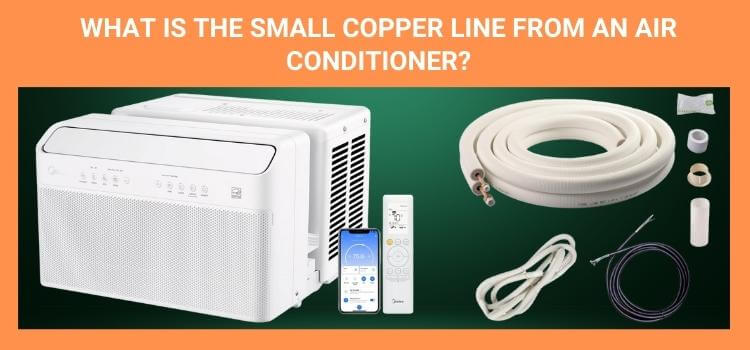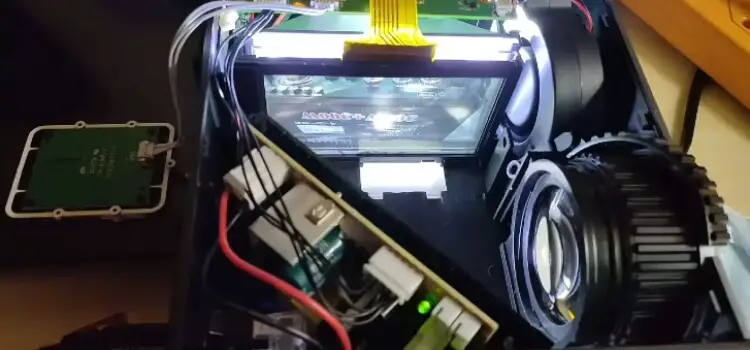As an Amazon Associate I earn from qualifying purchases.

Air conditioners are essential appliances in modern homes, providing comfort during scorching summers. Have you ever wondered about the small copper line running from your air conditioner? This inconspicuous component plays a vital role in the cooling process, yet many overlook its significance. This article will dive deep into understanding “What is the small copper line from an air conditioner?” We will explore its function, importance, and how it contributes to the efficient operation of your cooling system. So, let’s embark on this journey to gain expert insights into air conditioning and its fundamental components.
What is the Small Copper Line from an Air Conditioner?
The small copper line from an air conditioner is the liquid line. It transports the liquid refrigerant between the evaporator coil and the compressor. The liquid refrigerant absorbs heat from the air as it passes through the evaporator coil and transforms into vapor.
The vaporized refrigerant then flows back to the compressor, which is compressed and sent back to the evaporator coil.
The liquid line is typically smaller in diameter than the suction line, which is the line that carries the vapor refrigerant from the evaporator coil back to the compressor. The liquid refrigerant is under higher pressure than the vapor refrigerant, so it does not need as large a diameter to flow through.
The liquid line is usually insulated to prevent heat loss. This is important because the liquid refrigerant is very cold, and if it loses heat, it will not be able to absorb as much heat from the air.
If the liquid line is damaged, it can cause the air conditioner to lose refrigerant. This will reduce the air conditioner’s efficiency and may cause it to stop working altogether. If you suspect the liquid line is damaged, call a qualified HVAC technician to repair it.
Here are some of the signs that the liquid line in your air conditioner may be damaged:
- Your air conditioner used to be more relaxed than it is.
- You hear a hissing sound coming from the air conditioner.
- You see water dripping from the air conditioner.
- You see frost on the evaporator coil.
Call a qualified HVAC technician to inspect your air conditioner if you notice any of these signs.
The Purpose of the Small Copper Line
The primary purpose of the small copper line is to transport the refrigerant between the evaporator and the condenser coil. During the cooling cycle, the refrigerant absorbs heat from indoor air at the evaporator coil, turning it into a low-pressure gas. When it reaches the outside unit, where the condenser coil releases the heat collected, the refrigerant is transformed into a high-pressure liquid. It then travels via the little copper line there. This continuous cycle enables the air conditioner to maintain a comfortable indoor temperature.
How Does the Small Copper Line Work?
To comprehend how the small copper line functions, it’s essential to understand the basic principles of refrigeration. The cooling process relies on the ability of refrigerants to change states between gas and liquid at varying temperatures and pressures. This phenomenon is created by compressing and expanding the refrigerant within a closed-loop system made up of a small copper line.
The journey of the refrigerant starts at the evaporator coil, located inside the indoor unit. Here, the liquid refrigerant evaporates, absorbing heat from the indoor air and turning into a low-pressure, low-temperature gas. The small copper line carries this gas to the outdoor unit, where the condenser coil comes into play.
The outside unit’s condenser coil disperses the heat absorbed into the environment. As the refrigerant gives off heat, it undergoes condensation and turns back into a high-pressure liquid. The small copper line now carries this high-pressure liquid back to the indoor unit, where the process begins anew.
Importance of Proper Small Copper Line Sizing
One crucial aspect of the small copper line is its size, which plays a significant role in efficiently operating the air conditioner. The line’s diameter must be appropriately sized to ensure optimal refrigerant flow and prevent pressure imbalances within the system.
A small, narrow copper line can restrict refrigerant flow, and cooling capacity, and increase energy consumption. On the other hand, an oversized copper line may cause refrigerant pooling and inefficient heat exchange, negatively impacting the AC’s performance.
To determine the correct size of the small copper line, HVAC technicians consider factors like the length, the indoor and outdoor unit’s capacities, and the specific refrigerant being used. Proper sizing is crucial to maximizing the air conditioner’s efficiency and longevity.
Common Issues with the Small Copper Line
While the small copper line is durable, specific issues can arise over time. Awareness of these problems is essential to ensuring timely maintenance and preventing potential breakdowns. Some common topics include:
Refrigerant Leaks
Wear and tear, or faulty installation may lead to refrigerant leakage. These leaks impact cooling efficiency and pose environmental hazards, as refrigerants are known to contribute to ozone depletion.
Corrosion
Copper is susceptible to corrosion, especially in areas with high humidity or salt exposure. Corrosion can weaken the line and lead to leaks or ruptures.
Clogging
Dirt, debris, or contaminants in the refrigerant can cause clogging in the small copper line, impeding the smooth flow of the refrigerant.
Insulation Damage
The small copper line is often insulated to prevent condensation and improve energy efficiency. Damaged insulation can lead to energy losses and reduced cooling performance.
Improper Sloping
The small copper line should be sloped correctly to allow for proper drainage of condensed water. If not adequately sloped, water can accumulate and cause issues.
To address these problems, regular maintenance by qualified HVAC technicians is crucial. Timely inspections and repairs can extend the lifespan of the small copper line and enhance the overall performance of the air conditioning system.
FAQs about the Small Copper Line from an Air Conditioner:
The refrigerant line should be made of copper since it has strong corrosion resistance and is a superb heat conductor.
Non-professionals are not recommended to attempt replacing the small copper line due to the complexity of the AC system and potential safety hazards.
Inspecting your AC system, including the small copper line, at least once a year to detect any potential issues early on is advisable.
While a damaged line can impact cooling efficiency, it is not directly linked to health issues. However, refrigerant leaks can be harmful to the environment.
Reduced cooling performance, hissing sounds, and ice buildup on the copper line are common signs of a refrigerant leak.
Corrosion may be prevented, and the lifespan of the copper line increased by applying protective coatings or ensuring it is well insulated.
Conclusion
The small copper line from an air conditioner may seem inconspicuous, but its role in the cooling process is vital. Understanding its function and significance can help homeowners appreciate the complexity of their AC systems. To remain functional, the little copper line must have appropriate maintenance and prompt repairs. If you notice any issues with your air conditioner, it is best to seek professional assistance to maintain optimal cooling performance and ensure the longevity of your cooling system.
Related Post
Amazon and the Amazon logo are trademarks of Amazon.com, Inc, or its affiliates.




Leave a Reply